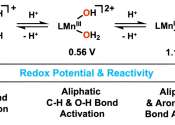Catalysis is the process in which the rate of a chemical reaction is either increased or decreased by means of a chemical substance known as a catalyst. Unlike other reagents that participate in the chemical reaction, a catalyst is not consumed by the reaction itself. The catalyst may participate in multiple chemical transformations. Catalysts that speed the reaction are called positive catalysts. Catalysts that slow down the reaction are called negative catalysts or inhibitors. Substances that increase the activity of catalysts are called promoters and substances that deactivate catalysts are called catalytic poisons. For instance, in the reduction of ethyne to ethene, the catalyst is palladium (Pd) partly "poisoned" with lead(II) acetate (Pb(CH3COO)2). Without the deactivation of the catalyst, the ethene produced will be further reduced to ethane.
The general feature of catalysis is that the catalytic reaction has a lower rate-limiting free energy change to the transition state than the corresponding uncatalyzed reaction, resulting in a larger reaction rate at the same temperature. However, the mechanistic origin of catalysis is complex. Catalysts may affect the reaction environment favorably, e.g. acid catalysts for reactions of carbonyl compounds, form specific intermediates that are not produced naturally, such as osmate esters in osmium tetroxide-catalyzed dihydroxylation of alkenes, or cause lysis of reagents to reactive forms, such as atomic hydrogen in catalytic hydrogenation.
Kinetically, catalytic reactions behave like typical chemical reactions, i.e. the reaction rate depends on the frequency of contact of the reactants in the rate-determining step. Usually, the catalyst participates in this slow step, and rates are limited by amount of catalyst. In heterogeneous catalysis, the diffusion of reagents to the surface and diffusion of products from the surface can be rate determining. Analogous events associated with substrate binding and product dissociation apply to homogeneous catalysts.
Although catalysts are not consumed by the reaction itself, they may be inhibited, deactivated or destroyed by secondary processes. In heterogeneous catalysis, typical secondary processes include coking where the catalyst becomes covered by polymeric side products. Additionally, heterogeneous catalysts can dissolve into the solution in a solid-liquid system or evaporate in a solid-gas system.









